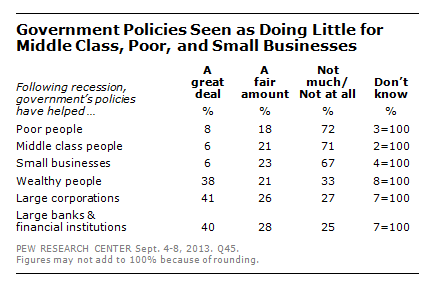Trump's Economic Agenda: Winners And Losers

Table of Contents
Tax Cuts and Their Impact
The cornerstone of Trump's economic plan was the 2017 Tax Cuts and Jobs Act. This landmark legislation significantly lowered corporate and individual income tax rates, aiming to stimulate economic growth.
The 2017 Tax Cuts and Jobs Act: A Closer Look
- Benefits: The act resulted in increased corporate profits, a short-term boost to economic growth, and a surge in the stock market. Many corporations used the tax savings for stock buybacks, enriching shareholders.
- Drawbacks: The substantial tax cuts dramatically increased the national debt. Critics argued the benefits were disproportionately concentrated among the wealthy, with limited impact on long-term economic growth for many lower and middle-income families. The promised job creation did not materialize to the extent predicted.
Impact on Businesses: A Tale of Two Sectors
- Winners: Large corporations, particularly those with significant overseas profits, were the primary beneficiaries of the lower corporate tax rate. Shareholders also saw substantial gains.
- Losers: Small businesses often faced increased compliance costs associated with the new tax code, outweighing any benefits. Many lower and middle-income earners saw minimal tax relief, if any.
Long-Term Effects of Tax Cuts: A Looming Shadow
The long-term consequences of the 2017 tax cuts remain a subject of debate. The increased national debt poses a significant challenge to future economic stability and could necessitate cuts to social programs. The widening income inequality further exacerbated existing societal divisions. The lack of sustained, widespread job creation fueled concerns about the true effectiveness of the tax cuts as a stimulus measure.
Trade Policies and Their Consequences: Protectionism's Price
Trump's administration adopted a protectionist trade policy, marked by increased tariffs and renegotiation of existing trade agreements.
Tariffs and Trade Wars: Winners and Losers in a Global Clash
- Winners: Certain domestic industries, such as steel and aluminum producers, benefited from tariffs that protected them from foreign competition. However, this protection came at a significant cost.
- Losers: Consumers faced higher prices on imported goods due to tariffs. Businesses reliant on imported materials or components saw increased costs, impacting their profitability and competitiveness. Farmers were particularly hard hit by retaliatory tariffs imposed by other countries.
Renegotiation of Trade Agreements: USMCA and its Ramifications
The renegotiation of NAFTA into the United States-Mexico-Canada Agreement (USMCA) aimed to improve labor standards and protect certain US industries.
- Winners: Some US industries benefited from revised rules of origin and other provisions. The agreement included provisions intended to improve labor standards in Mexico.
- Losers: Businesses that had adapted to and thrived under the NAFTA framework faced uncertainty and potential disruptions. The impact on consumers was mixed, with some potential for price fluctuations.
Impact on Global Trade Relations: A Damaged Reputation?
Trump's trade policies significantly strained US relationships with key trading partners, leading to increased uncertainty in the global trading system. The imposition of tariffs ignited trade wars, harming global economic growth and damaging the US reputation as a reliable trading partner. The long-term effects on global trade relations are still unfolding.
Deregulation and Its Effects: Balancing Growth and Risk
Trump's administration pursued a policy of deregulation across various sectors, aiming to reduce the regulatory burden on businesses.
Environmental Regulations: A Costly Retreat?
- Winners: The fossil fuel industry and other businesses with reduced environmental compliance requirements saw significant short-term gains.
- Losers: Environmental protection advocates and communities facing increased pollution bore the brunt of the relaxed environmental standards. Long-term environmental consequences, including climate change, remain a major concern.
Financial Regulations: Risk and Reward
- Winners: Financial institutions benefited from reduced oversight, potentially leading to increased profits but also increased risk.
- Losers: Consumers potentially faced greater financial risk due to decreased regulatory protection. The long-term stability of the financial system remains a critical concern.
Labor Regulations: The Worker's Perspective
- Winners: Businesses saw reduced labor costs, potentially increasing profitability.
- Losers: Workers faced potential reductions in protections and wages, leading to increased income inequality and precarious employment situations.
Conclusion: Assessing the Legacy of Trump's Economic Agenda
Trump's economic agenda, characterized by significant tax cuts, protectionist trade policies, and deregulation, had a profound and multifaceted impact on the US economy. While some sectors and individuals experienced significant benefits, others faced substantial losses. The long-term consequences of these policies are still unfolding, and their effects on income inequality, national debt, and international relations remain subjects of ongoing debate. Understanding the winners and losers under Trump's economic agenda is crucial for informed policy discussions and future economic planning. Further research into the lasting effects of Trump's Economic Agenda is vital for a complete understanding. Analyzing the full impact of Trump's economic policies requires further study and careful consideration of all the variables involved.

Featured Posts
-
 Investment Opportunities A Map Of The Countrys Promising Business Regions
Apr 22, 2025
Investment Opportunities A Map Of The Countrys Promising Business Regions
Apr 22, 2025 -
 Stock Market Today Dow Futures Dollar And Trade War Concerns
Apr 22, 2025
Stock Market Today Dow Futures Dollar And Trade War Concerns
Apr 22, 2025 -
 Land Your Dream Private Credit Job 5 Dos And Don Ts To Follow
Apr 22, 2025
Land Your Dream Private Credit Job 5 Dos And Don Ts To Follow
Apr 22, 2025 -
 Pope Francis Dies At 88 Remembering His Impact On The Catholic Church
Apr 22, 2025
Pope Francis Dies At 88 Remembering His Impact On The Catholic Church
Apr 22, 2025 -
 Price Gouging Allegations Against La Landlords Surface After Recent Fires
Apr 22, 2025
Price Gouging Allegations Against La Landlords Surface After Recent Fires
Apr 22, 2025
